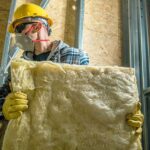The building industry is on the verge of a revolution, driven by ground-breaking advances in materials and processes. As we confront the issues of sustainability, efficiency, and safety, the introduction of new building materials and construction techniques provides a ray of hope. This blog digs into some of the most promising advancements poised to transform the building industry.
Self-Healing Concrete: A Leap Toward Durability
Concrete, the foundation of construction, has undergone a revolutionary innovation: self-healing concrete. This material, which is infused with limestone-producing bacteria, can naturally mend cracks when exposed to water, dramatically increasing longevity and lowering maintenance costs. Consider buildings that repair themselves, mirroring the resilience of natural organisms. This technology not only promises to increase the life of buildings, but it also helps to promote sustainability by minimizing the need for repairs and new materials.
Energy-Efficient Insulating Materials: The Pursuit of Sustainability
As the globe shifts toward more environmentally friendly construction techniques, energy-efficient insulating materials have taken center stage. Aerogel insulation, with its exceptional thermal qualities and low environmental impact, is revolutionizing how buildings retain heat and manage temperatures. This breakthrough is critical in the effort to minimize energy usage and carbon footprints, making buildings more pleasant and environmentally sustainable.
Modular Construction: Speed and Efficiency Redefined
Modular construction, in which structures are built in sections off-site and then erected on-site, is transforming the construction timetable and efficiency. This method not only accelerates the construction process but also considerably lowers waste and interruption on-site. By transferring much of the work to regulated manufacturing environments, modular construction assures higher quality, faster delivery, and a greener approach to construction.
3D Printing in Construction: Customization and Efficiency
3D printing technology has made its way into building, providing unprecedented flexibility and efficiency. From intricate architectural pieces to complete buildings, 3D printing minimizes waste and enables bespoke construction solutions at a fraction of the usual time and expense. This technology’s flexibility to use a variety of materials, including eco-friendly alternatives, adds to its popularity in sustainable construction methods.
Graphene: The Supermaterial
Graphene, frequently referred to as a wonder material, is making an impact on the building business. Its integration with architectural materials increases strength, durability, and electrical conductivity. Consider concrete and steel that are not only stronger and lighter, but also carry electricity, opening the path for novel uses such as energy-harvesting buildings.
Visualizing the future
To help visualize these improvements, consider the following image: a futuristic cityscape with buildings made using these novel materials and procedures. Self-healing bridges span waterways, high-rises shine with energy-efficient coatings, and modular dwellings dot the landscape, all meticulously built and intended for sustainability.
The future of construction seems promising, with breakthrough materials and processes paving the way for more sustainable, efficient, and resilient building practices. As we continue to research and execute these improvements, we pave the path for a construction environment that not only fulfills today’s expectations but is also ready for tomorrow’s difficulties. The building industry’s transition is about more than simply new materials and technology; it’s about reinventing how we create spaces for living, working, and connecting that are both environmentally conscious and responsive to our changing demands.








